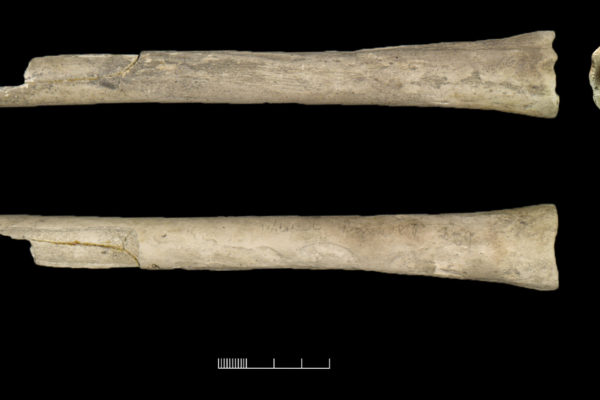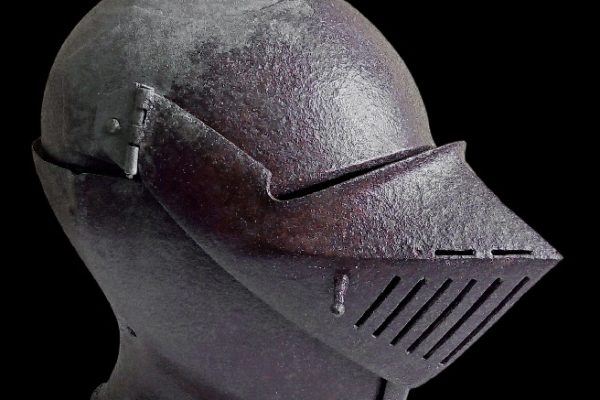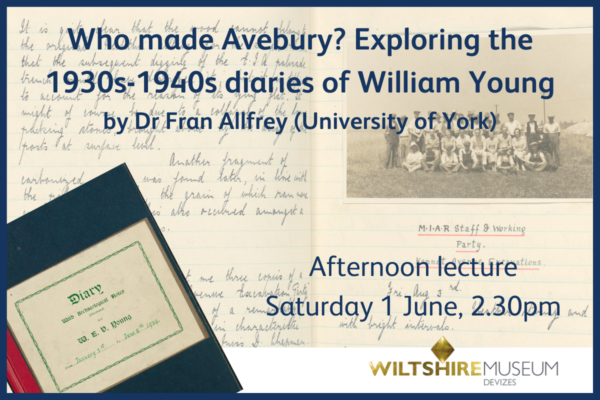Wiltshire Museum has been awarded £47,000 over two years, from the Arts Council England Designation Development Fund, to review the research undertaken on the archaeology collections of Wiltshire Museum and The Salisbury Museum over the past decade.
A Wealth of Knowledge: unlocking a decade of archaeological research is a joint project between Wiltshire Museum in Devizes and The Salisbury Museum, to ensure that the results of ground-breaking research becomes an integral part of both museum’s collection management systems, culminating in a combined Wessex Museums online archaeology database.
The project will enable the two museums to review research undertaken by some of the 200 postgraduate researchers who have studied their archaeology collections in the last ten years and ensure that the stories uncovered are accessible to all. The museums will then be able to highlight research potential in currently under developed areas of the collections. The research will also enable the museums to engage with wider audiences by ensuring that the latest information is included in gallery displays, lectures and conferences, and accessible online on a new website.
Starting in April 2020 this two-year project will be undertaken by a Research Officer working alongside Wiltshire Museum Curator, Lisa Brown. She said “Since 2010, more than 200 post-graduate researchers from universities across the country have consulted the collections at the Wiltshire and Salisbury museums. This has helped to build our reputation as a centre of academic research, thus making the museums a focal point for some of the latest work undertaken and ultimately building our knowledge of the past. This project to make research results more widely available, will truly cement our reputation as a hub for academic research in archaeology.”
Phil Gibby, Area Director, South West, Arts Council England, said: “We are delighted to support this joint project between Wiltshire Museum and Salisbury Museum through our Designation Development Fund, with thanks to the National Lottery. The project will ensure the long-term sustainability of the museums’ excellent archaeology collections whilst enabling further development into research. We are extremely pleased that this funding will allow the hidden stories within these nationally significant collections to become more visible, and allow more people to enjoy the benefits of cultural activity.”
The project is comprised of five elements:
- 1. Updating Object Records
A considerable amount of research has been undertaken on the Wiltshire and Salisbury museums’ collections over the last 10 years, ranging from post-graduate to independent researchers. However, a limited amount of the results of this research has been fed back to the museum collection management system (MODES). One of the main aims of the project is to identify the results of this research and update the museum records.
One such research project is the Ritual in Early Bronze Age Grave Goods: An examination of ritual and dress equipment from Chalcolithic and Early Bronze Age graves in England. A Woodward and J Hunter, 2015. The Research Officer will start by updating the existing MODES records for these objects. The Research Officer will also work with the Curator to identify other research undertaken on the collections and update the associated MODES records. The newly enhanced records will include more detailed descriptions of individual objects, as well as information about destructive analysis, loans, new photography, bibliographic references, and new knowledge derived from the research.
- 2. Create an Enhanced Online Collections Database
The enhanced MODES records will then be uploaded to the Wiltshire and Salisbury museum’s websites, making them accessible to researchers in the widest possible terms. There are also plans to create a central database for the Wessex Museums Partnership, bringing together all those collections online. Both Wiltshire Museum and Salisbury Museum are partners in the Wessex Museums Partnership, National Portfolio Organisation led by Poole Museums Service and including Dorset County Museum. This is particularly important where our collecting areas overlap in areas of great research interest, such as the Stonehenge landscape. Enhanced collections records will be prioritized in online searches and displayed as ‘Collections Highlights’ on the museums websites.
- 3. New Interpretation and Updating Displays
As the project proceeds, and new information is added to the collection records, the Wiltshire Museum will review the potential impact this may have on the current interpretation in the museum, with the aim of updating gallery displays. An example of this is the recent analysis of the source of the gold studs used to decorate the handle of the dagger from the Bush Barrow Chieftain. The new knowledge from this analysis changes our current thinking on the manufacture and provenance of the dagger, and will need to be reflected in its interpretation and display. Wiltshire Museum will also explore the potential to incorporate simple digital displays to highlight ongoing research into the collections – including interviews with researchers, explaining their work.
- 4. Identifying Future Research Potential
By collating and assessing the research already undertaken over the past decade, it will also be possible to identify the under-researched areas of the collections, with a view to promoting them as possible areas of future enquiry. Working with our academic partners, we will host a series of seminars to identify joint research priorities for the Wiltshire and Salisbury museum collections. These seminars will organised by the Research Officer and will include the opportunity for researchers to visit stores and review archaeological archives. The identified research priorities will be launched at the Archaeology in Wiltshire Conference in the Spring of 2022. This work will feed into the development of a research framework for the museum.
- 5. Help to Improve the Reporting and Enhancement of Future Research Outputs
By supporting the Curator to enhance the current Wiltshire Museum Research Charter and develop internal processes that will enable future research to be fed back to enhance collection records. This will include academic research and the results of development-led investigations, helping to identify significant collections that can be highlighted for their research potential (higher education and other researchers). Ways to improve the public value of research will also be explored.
About the Organisations
- Arts Council England is the national development body for arts and culture across England, working to enrich people’s lives. We support a range of activities across the arts, museums and libraries – from theatre to visual art, reading to dance, music to literature, and crafts to collections. Great art and culture inspires us, brings us together and teaches us about ourselves and the world around us. In short, it makes life better. Between 2018 and 2022, we will invest £1.45 billion of public money from government and an estimated £860 million from the National Lottery to help create these experiences for as many people as possible across the country. artscouncil.org.uk
- Salisbury Museum Each year, over 30,000 visitors from across the UK and the world come to visit The Salisbury Museum. Using the extraordinary breadth of its collections and award-winning exhibitions, it brings to life the narrative of this part of the English landscape – the people who shaped it and have been inspired by it for over 500,000 years. The Wessex Gallery, which opened in 2014, houses one of Europe’s most extensive collections of Stonehenge and pre-historic artefacts. salisburymuseum.org.uk.
- Wessex Museums is a partnership of four museums: Dorset Museum, Poole Museum, The Salisbury Museum and Wiltshire Museum. It supports and amplifies the work of the partner museums by sharing and collaborating, to build the resilience of the museums and make them relevant to diverse audiences. The partner museums are working to inspire people to explore and enjoy the outstanding art and heritage of the Wessex region. wessexmuseums.org.uk
Project Update: 26 March 2021
Despite the challenges bought about by Covid-19, the project started in earnest last April and a great deal has been achieved in the last year.
Our Researcher Officer, Wil Partridge, was appointed, and his MODES training was delivered on-line using Zoom. Largely working from home, Wil has made contact with most of the researchers who have visited the two museums over the past ten years to research the collections, and we now have copies of their PhD theses and publications.
So far, the project has identified 590 individual objects accessed 688 times, resulting in 781 MODES records being updated, with significantly more detailed information. These 'enhanced' database records include more comprehensive descriptions of the individual objects, 250 new photographs, and in some cases, and most importantly, a whole new understanding of the use and significance of the objects themselves.
In addition to updating the MODES database with the results of all this research, Wil has also recorded a number of details about what objects are being accessed and what methodologies are being used. In addition to accession number and methodology, he is also recording how many times an object has been accessed, its material, object type, site, parish, context and archaeological period. This will enable the museum to accurately quantify how different aspects of the collections are being used when creating a future Research Agenda.
As expected, the results reveal that the museum’s early Bronze Age collections are accessed most often – the finds made from the early excavations of the barrows located in the Stonehenge and Avebury WHS. By reviewing the research that has been undertaken on collections over the past ten years, it has been possible for the museum to identify the under-researched areas of the collections, eventually to then promote them as possible areas of future enquiry to post-graduate students. We hope this will include new topics, focussing on the Iron Age, Roman, and pre-Neolithic collections.
Next steps…….. getting the new collections information online; reviewing the collections of Salisbury Museum; progressing seminars with our colleagues in academia to inform a Research Agenda for the archaeology collection going forward; making a plan to integrate the results of this research into existing museum galleries and displays.
Lisa Brown, Curator
Wil Partridge, Research Officer

Research at the Museum
Find out more about our collections and our Research Charter.
Example of research undertaken into an object in our collections
Peter Marshall talking about sampling for Radiocarbon dating
Katy Whitaker talking about her research on Sarsen stone
Adele Bricking talking about Iron Age mortuary practices
Chris Standish talking about his analysis of a stud from the Bush Barrow dagger
Online talks featuring collections research
-

ONLINE TALK: Show and Tell – a look at some new acquisitions
An online ‘show and tell’ highlighting some recent additions to the Wiltshire Museum collections. Join Curator, Lisa Brown, Friday Schoemaker, Assizes for Devizes…
-

From Milan to Draycot Cerne. The Funerary Helmet of Sir Thomas Long
This is the intriguing story of the helmet, on display at Wiltshire Museum, which was worn by Sir Thomas Long of Draycot Cerne,…
-

LECTURE: Who made Avebury? Exploring the 1930s-1940s diaries of William Young
In this talk, Dr Fran Allfrey (University of York) is joined by Prue Saunders and Bev Stapleton, research volunteers for the Avebury Papers…
-
ONLINE TALK: New to the Museum: Wiltshire’s stories through our collections
Join us for an online ‘show and tell’ highlighting some recent additions to our collections. Ranging from a Saxon jewel to stones from…





